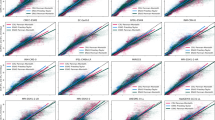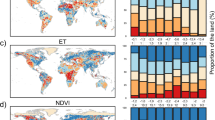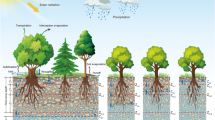Abstract
Accurate quantification of global land evapotranspiration is necessary for understanding variability in the global water cycle, which is expected to intensify under climate change1,2,3. Current global evapotranspiration products are derived from a variety of sources, including models4,5, remote sensing6,7 and in situ observations8,9,10. However, existing approaches contain extensive uncertainties; for example, relating to model structure or the upscaling of observations to a global level11. As a result, variability and trends in global evapotranspiration remain unclear12. Here we show that global land evapotranspiration increased by 10 ± 2 per cent between 2003 and 2019, and that land precipitation is increasingly partitioned into evapotranspiration rather than runoff. Our results are based on an independent water-balance ensemble time series of global land evapotranspiration and the corresponding uncertainty distribution, using data from the Gravity Recovery and Climate Experiment (GRACE) and GRACE-Follow On (GRACE-FO) satellites13. Variability in global land evapotranspiration is positively correlated with El Niño–Southern Oscillation. The main driver of the trend, however, is increasing land temperature. Our findings provide an observational constraint on global land evapotranspiration, and are consistent with the hypothesis that global evapotranspiration should increase in a warming climate.
This is a preview of subscription content, access via your institution
Access options
Access Nature and 54 other Nature Portfolio journals
Get Nature+, our best-value online-access subscription
$29.99 / 30 days
cancel any time
Subscribe to this journal
Receive 51 print issues and online access
$199.00 per year
only $3.90 per issue
Buy this article
- Purchase on Springer Link
- Instant access to full article PDF
Prices may be subject to local taxes which are calculated during checkout



Similar content being viewed by others
Data availability
The data that support the findings of this study have been added to the Zenodo repository and can be accessed at https://doi.org/10.5281/zenodo.4601596. Source data are provided with this paper.
Code availability
The code that produced the findings of this study is available from the corresponding author upon reasonable request.
Change history
24 February 2022
A Correction to this paper has been published: https://doi.org/10.1038/s41586-022-04525-3
References
Held, I. M. & Soden, B. J. Robust responses of the hydrological cycle to global warming. J. Clim. 19, 5686–5699 (2006).
Greve, P. et al. Global assessment of trends in wetting and drying over land. Nat. Geosci. 7, 716–721 (2014); corrigendum 7, 848 (2014).
Huntington, T. G. Evidence for intensification of the global water cycle: review and synthesis. J. Hydrol. 319, 83–95 (2006).
Mueller, B. et al. Evaluation of global observations-based evapotranspiration datasets and IPCC AR4 simulations. Geophys. Res. Lett. 38, L06402 (2011).
Haddeland, I. et al. Multi-model estimate of the global terrestrial water balance: setup and first results. J. Hydrometeorol. 12, 869–884 (2011).
Mu, Q., Heinsch, F. A., Zhao, M. & Running, S. W. Development of a global evapotranspiration algorithm based on MODIS and global meteorology data. Remote Sens. Environ. 111, 519–536 (2007).
Rodell, M. et al. The observed state of the water cycle in the early twenty-first century. J. Clim. 28, 8289–8318 (2015).
Fisher, J. B., Tu, K. P. & Baldocchi, D. D. Global estimates of the land–atmosphere water flux based on monthly AVHRR and ISLSCP-II data, validated at 16 FLUXNET sites. Remote Sens. Environ. 112, 901–919 (2008).
Jung, M. et al. The FLUXCOM ensemble of global land-atmosphere energy fluxes. Sci. Data 6, 74 (2019).
Hobeichi, S., Abramowitz, G., Evans, J. & Ukkola, A. Derived Optimal Linear Combination Evapotranspiration (DOLCE): a global gridded synthesis ET estimate. Hydrol. Earth Syst. Sci. 22, 1317–1336 (2018).
Baldocchi, D. Assessing the eddy covariance technique for evaluating carbon dioxide exchange rates of ecosystems: past, present and future. Glob. Change Biol. 9, 479–492 (2003).
Fisher, J. B. et al. The future of evapotranspiration: global requirements for ecosystem functioning, carbon and climate feedbacks, agricultural management, and water resources. Water Resour. Res. 53, 2618–2626 (2017).
Tapley, B. D., Bettadpur, S., Ries, J. C., Thompson, P. F. & Watkins, M. M. GRACE measurements of mass variability in the Earth system. Science 305, 503–505 (2004).
Trenberth, K., Smith, L., Qian, T., Dai, A. & Fasullo, J. Estimates of the global water budget and its annual cycle using observational and model data. J. Hydromeorol. 8, 758–769 (2007).
Mu, Q., Zhao, M. & Running, S. W. Improvements to a MODIS global terrestrial evapotranspiration algorithm. Remote Sens. Environ. 115, 1781–1800 (2011).
Anderson, M. C., Allen, R. G., Morse, A. & Kustas, W. P. Use of Landsat thermal imagery in monitoring evapotranspiration and managing water resources. Remote Sens. Environ. 122, 50–65 (2012).
Allan, R. et al. Advances in understanding large-scale responses of the water cycle to climate change. Ann. NY Acad. Sci. 1472, 49–75 (2020).
Milly, P. C. & Dunne, K. A. Potential evapotranspiration and continental drying. Nat. Clim. Change 6, 946–949 (2016).
Jung, M. et al. Recent decline in the global land evapotranspiration trend due to limited moisture supply. Nature 467, 951–954 (2010).
Miralles, D. G. et al. El Niño–La Niña cycle and recent trends in continental evaporation. Nat. Clim. Change 4, 122–126 (2014).
Dong, B. & Dai, A. The uncertainties and causes of the recent changes in global evapotranspiration from 1982 to 2010. Clim. Dyn. 49, 279–296 (2017); correction 53, 3707–3708 (2019).
Zhang, K. et al. Vegetation greening and climate change promote multidecadal rises of global land evapotranspiration. Sci. Rep. 5, 15956 (2015).
Douville, H., Ribes, A., Decharme, B., Alkama, R. & Sheffield, J. Anthropogenic influence on multidecadal changes in reconstructed global evapotranspiration. Nat. Clim. Change 3, 59–62 (2013).
Swann, A. L. & Koven, C. D. A direct estimate of the seasonal cycle of evapotranspiration over the Amazon Basin. J. Hydrometeorol. 18, 2173–2185 (2017).
Pascolini-Campbell, M. A., Reager, J. T. & Fisher, J. B. GRACE-based mass conservation as a validation target for basin-scale evapotranspiration in the contiguous United States. Water Resour. Res. 56, e2019WR026594 (2020).
Li, X. et al. Evapotranspiration estimation for Tibetan Plateau headwaters using conjoint terrestrial and atmospheric water balances and multisource remote sensing. Wat. Resour. Res. 55, 8608–8630 (2019).
Ramillien, G. et al. Time variations of the regional evapotranspiration rate from Gravity Recovery and Climate Experiment (GRACE) satellite gravimetry. Wat. Resour. Res. 42, W10403 (2006).
Rodell, M. et al. Basin scale estimates of evapotranspiration using GRACE and other observations. Geophys. Res. Lett. 31, L20504 (2004).
Billah, M. M. et al. A methodology for evaluating evapotranspiration estimates at the watershed-scale using GRACE. J. Hydrol. 523, 574–586 (2015).
Rodell, M., McWilliams, E. B., Famiglietti, J. S., Beaudoing, H. K. & Nigro, J. Estimating evapotranspiration using an observation based terrestrial water budget. Hydrol. Process. 25, 4082–4092 (2011).
Liu, W. et al. A worldwide evaluation of basin-scale evapotranspiration estimates against the water balance method. J. Hydrol. 538, 82–95 (2016).
Dai, A., Qian, T., Trenberth, K. E. & Milliman, J. D. Changes in continental freshwater discharge from 1948 to 2004. J. Clim. 22, 2773–2792 (2009).
Chandanpurkar, H. A., Reager, J. T., Famiglietti, J. S. & Syed, T. H. Satellite- and reanalysis-based mass balance estimates of global continental discharge (1993–2015). J. Clim. 30, 8481–8495 (2017).
Syed, T. H., Famiglietti, J. S., Chambers, D. P., Willis, J. K. & Hilburn, K. Satellite-based global-ocean mass balance estimates of interannual variability and emerging trends in continental freshwater discharge. Proc. Natl Acad. Sci. USA 107, 17916–17921 (2010).
Ropelewski, C. F. & Halpert, M. S. North American precipitation and temperature patterns associated with the El Niño/Southern Oscillation (ENSO). Mon. Weath. Rev. 114, 2352–2362 (1986).
Ropelewski, C. F. & Halpert, M. S. Precipitation patterns associated with the high index phase of the Southern Oscillation. J. Clim. 2, 268–284 (1989).
Trenberth, K. E., Fasullo, J. T. & Kiehl, J. Earth’s global energy budget. Bull. Am. Meteorol. Soc. 90, 311–324 (2009).
Landerer, F. W. et al. Extending the global mass change data record: GRACE Follow-On instrument and science data performance. Geophys. Res. Lett. 47, e2020GL088306 (2020).
Scanlon, B. R. et al. Global models underestimate large decadal declining and rising water storage trends relative to GRACE satellite data. Proc. Natl Acad. Sci. USA 115, E1080–E1089 (2018).
Wiese, D. N., Landerer, F. W. & Watkins, M. M. Quantifying and reducing leakage errors in the JPL RL05M GRACE mascon solution. Water Resour. Res. 52, 7490–7502 (2016).
Landerer, F. W., Dickey, J. O. & Guntner, A. Terrestrial water budget of the Eurasian pan-Arctic from GRACE satellite measurements during 2003–2009. J. Geophys. Res. D 115, D23115 (2010).
Long, D., Longuevergne, L. & Scanlon, B. R. Uncertainty in evapotranspiration from land surface modeling, remote sensing, and GRACE satellites. Water Resour. Res. 50, 1131–1151 (2014).
Adler, R. F. et al. The Global Precipitation Climatology Project (GPCP) monthly analysis (new version 2.3) and a review of 2017 global precipitation. Atmosphere 9, 138 (2018).
Kalnay, E. et al. The NCEP/NCAR 40-Year Reanalysis Project. Bull. Am. Meteorol. Soc. 77, 437–472 (1996).
Gelaro, R. et al. The Modern-Era Retrospective Analysis for Research and Applications, Version 2 (MERRA-2). J. Clim. 30, 5419–5454 (2017).
Hersbach, H. et al. The ERA5 global reanalysis. Q. J. R. Meteorol. Soc. 146, 1999–2049 (2020).
Suzuki, T. et al. A dataset of continental river discharge based on JRA-55 for use in a global ocean circulation model. J. Oceanogr. 74, 421–429 (2018).
Huffman, G. J. et al. The global precipitation climatology project (GPCP) combined precipitation dataset. Bull. Am. Meteorol. Soc. 78, 5–20 (1997).
Xie, P. P. & Arkin, P. A. Global precipitation: a 17-year monthly analysis based on gauge observations, satellite estimates, and numerical model outputs. Bull. Am. Meteorol. Soc. 78, 2539–2558 (1997).
Jin, X. & Weller, R. A. Multidecade Global Flux Datasets from the Objectively Analyzed Air–Sea Fluxes (OAFlux) Project: Latent and Sensible Heat Fluxes, Ocean Evaporation, and Related Surface Meteorological Variables OAFlux Project Technical Report OA-2008-01 (OAFlux Project, 2008).
Good, S. A., Martin, M. J. & Rayner, N. A. EN4: quality controlled ocean temperature and salinity profiles and monthly objective analyses with uncertainty estimates. J. Geophys. Res. Oceans 118, 6704–6716 (2013).
Rodell, M. et al. The Global Land Data Assimilation System. Bull. Am. Meteorol. Soc. 85, 381–394 (2004).
Huang, B. et al. Extended Reconstructed Sea Surface Temperature version 4 (ERSST.v4). Part I: upgrades and intercomparisons. J. Clim. 28, 911–930 (2015).
Lenssen, N. J. et al. Improvements in the GISTEMP uncertainty model. J. Geophys. Res. D 124, 6307–6326 (2019).
Gehne, M., Hamill, T. M., Kiladis, G. N. & Trenberth, K. E. Comparison of global precipitation estimates across a range of temporal and spatial scales. J. Clim. 29, 7773–7795 (2016).
Jolliffe, I. T. Uncertainty and inference for verification measures. Weather Forecast. 22, 637–650 (2007).
Bamber, J. et al. Land ice freshwater budget of the Arctic and North Atlantic oceans: 1. Data, methods, and results. J. Geophys. Res. Oceans 123, 1827–1837 (2018).
Rye, C. D. et al. Rapid sea-level rise along the Antarctic margins in response to increased glacial discharge. Nat. Geosci. 7, 732–735 (2014).
Depoorter, M. A. et al. Calving fluxes and basal melt rates of Antarctic ice shelves. Nature 502, 89–92 (2013); corrigendum 502, 580 (2013).
Acknowledgements
The research was carried out at the Jet Propulsion Laboratory, California Institute of Technology, under a contract with the National Aeronautics and Space Administration. Government sponsorship acknowledged. This work was supported by funding from NASA’s GRACE-FO Science Team, Principal Investigator J.T.R. We thank A. Bloom for sharing code used to produce the confidence interval plots.
Author information
Authors and Affiliations
Contributions
M.P.-C. conceived, and carried out the research, led the data analysis and wrote the manuscript. J.T.R. conceived the research, designed the analysis and provided comments on the manuscript. H.A.C. produced the global discharge dataset and also provided input on the analysis. M.R. provided comments on the manuscript.
Corresponding author
Ethics declarations
Competing interests
The authors declare no competing interests.
Additional information
Peer review information Nature thanks Di Long, Bart Nijssen and the other, anonymous, reviewer(s) for their contribution to the peer review of this work.
Publisher’s note Springer Nature remains neutral with regard to jurisdictional claims in published maps and institutional affiliations.
This article has been retracted. Please see the retraction notice for more detail: https://doi.org/10.1038/s41586-022-04525-3
Extended data figures and tables
Extended Data Fig. 1 Input water cycle timeseries.
a–c, The raw time series for global land precipitation (GPCPV2.3, MERRA-2, NOAA–NCEP and ERA-5) (a), discharge (JRA-55, and ocean mass-balance estimates EN4–OAFlux–GPCP, EN4–OAFlux–CMAP, EN4–ERA5, EN4–MERRA2) (b) and change in total water storage (dS/dt) from GRACE/GRACE-FO using three different methods to compute the derivate (backward difference with three-month smoothing, centred finite difference and backward difference) (c).
Extended Data Fig. 2 Error budget of water-balance components.
a, b, Monthly error time series for precipitation (a) and discharge (b) calculated as the standard deviation of input data sets. c, Error in dS/dt calculated from the formal GRACE JPL RL06 mascon error product, and propagated into derivative. Monthly time series of errors plotted for 2003 to 2019 in units of mm yr−1.
Extended Data Fig. 3 Ratios of water-balance components.
a–c, Ratios between components of the water balance for ET/Q (a), ET/Pr (b) and Q/Pr (c). In each case, the ratios are calculated using the time series with the seasonal cycle removed and 15-month smoothing applied. The ensemble mean for each variable (ET, Pr and Q) is used.
Extended Data Fig. 4 Water-balance relationship with ENSO.
Left: correlation with ERSST version 4 SST against ET (a), Pr (c), Q (e) and dS/dt (g). Right: time series of MEI index against ET (b), Pr (d), Q (f) and dS/dt (h). For each panel, the SST and water-balance variable have the seasonal cycle removed and a 15-month moving average filter applied. The r value of the correlation between the MEI and water-cycle variable are shown in top left corner (right panels). Stippling on the maps (left panels) indicates that the value of the Pearson correlation between the SST and the water-balance variable (ET, Pr, Q and dS/dt) at that grid point is significant (α = 0.05 level). Maps created using MATLAB with the M_Map package (online at https://www.eoas.ubc.ca/~rich/map.html).
Extended Data Fig. 5 Effect of ENSO and temperature.
a, Multiple linear regression of global surface temperature (yellow line) and MEI (red line) onto ET (blue line). b–d, Multiple regression of MEI (red line) onto Pr (b), Q (c) and dS/dt (d). In each, the input times series data has been filtered using a 15-month moving average. The amount of variability explained is indicated by R2 (top left corner of panels).
Extended Data Fig. 6 Effect of removing natural climate variability and temperature on ET.
a, ET anomaly time series (solid blue line) and linear trend (dashed blue line), and ET anomaly time series minus the multiple regression model of MEI onto ET (solid red lines) and trend (dashed red line). b, Same as a, but for multiple regression model of surface temperature. The value of the trends in mm yr−1 are indicated in the top left.
Extended Data Fig. 7 Influence of ENSO on ET products.
Left: correlation with ERSST version 4 SST against different ET products: ET (a), MOD16A2GF (c), FLUXCOM (e), PT-JPL (g) and GLDAS2.2 (i). Right: time series of MEI index against ET (b), MOD16A2GF (d), FLUXCOM (f), PT-JPL (h) and GLDAS2.2 (j). For each panel, the SST and water-balance variable have the seasonal cycle removed and a 15-month moving average filter applied. The r value of the correlation between MEI and ET shown in top left corner (right panels) (r values surrounded by () are not significant at the α = 0.05 level). Stippling on the maps (left panels) indicates that the value of the correlation at that grid point is significant (α = 0.05 level). Maps created using MATLAB with the M_Map package (online at https://www.eoas.ubc.ca/~rich/map.html).
Extended Data Fig. 8 Contribution of ice sheets to ET.
a–c, Seasonal cycle for ET, Pr, Q and dS/dt calculated without Greenland + Antarctica (a), without Antarctica (b) and with all global land (ET from this study) (c). The shading is the standard deviation among the bias-corrected seasonal cycle of the ET ensemble (red shading), and input datasets used for Pr (four datasets, blue shading), Q (five datasets, black shading) and dS/dt (three methods to calculate derivative from JPL RL06 GRACE TWS, teal shading). d–f, Ensemble of ET compared with other ET products for ET calculated without Greenland + Antarctica (d), without Antarctica (e) and with all global land (ET from this study) (f). The shading represents the confidence intervals for the ensemble of ET (range shown in the colour bar).
Source data
About this article
Cite this article
Pascolini-Campbell, M., Reager, J.T., Chandanpurkar, H.A. et al. RETRACTED ARTICLE: A 10 per cent increase in global land evapotranspiration from 2003 to 2019. Nature 593, 543–547 (2021). https://doi.org/10.1038/s41586-021-03503-5
Received:
Accepted:
Published:
Issue Date:
DOI: https://doi.org/10.1038/s41586-021-03503-5
This article is cited by
-
Distribution characteristics of drought and flood hazards in northern China against the background of climate warming
Natural Hazards (2024)
-
Diminishing storage returns of reservoir construction
Nature Communications (2023)
-
Land surface energy exchange over the rice-winter rape rotation system and its response to winter rape abandonment in the humid lowland region, southern China
Environmental Earth Sciences (2023)
-
Precipitation Intensification Increases Shrub Dominance in Arid, Not Mesic, Ecosystems
Ecosystems (2023)
-
Monitoring vegetation drought in the nine major river basins of China based on a new developed Vegetation Drought Condition Index
Journal of Arid Land (2023)
Comments
By submitting a comment you agree to abide by our Terms and Community Guidelines. If you find something abusive or that does not comply with our terms or guidelines please flag it as inappropriate.



